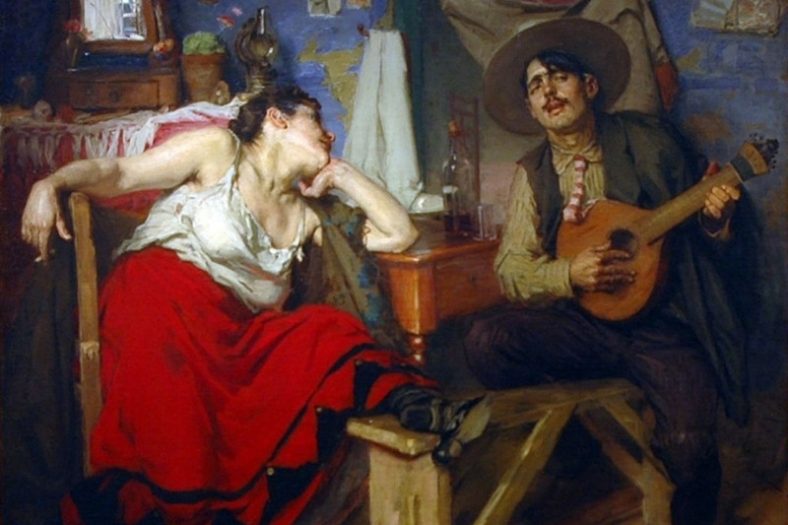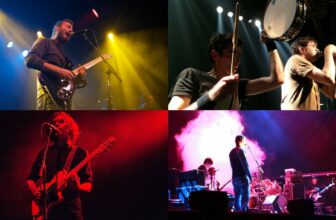What is Fado Music?

Fado music is a genre of Portuguese music featuring a singer accompanied by classic guitar and Portuguese guitar. The word ‘Fado’ comes from the Latin word ‘fatum’ and means fate. While many believe that Fado lyrics need to be mournful, there are plenty of Fado songs that explore cheerful topics.
Fado originates from Portugal, but it would be wrong to characterize it as a type of Latin music. And while Fado is often branded as World Music in countries like the United States and the United Kingdom, the term is simply too broad to accurately describe it. So, what is Fado?
To fully understand what Fado is all about, one must first analyze its musical and cultural properties.
Contents
What does Fado sound like?
Traditionally performed by a trio, Fado music generally features a solo singer, a classic guitar player, and a Portuguese guitar player. Additional instrumentation may include an acoustic bass and a mandolin. Typically, Fado doesn’t feature any percussive instruments.
Fado arrangements can be very simple or extremely complex. Typically, though, they include major and minor-seventh chords and rely extensively on guitar arpeggios. Due to its drumless nature and slow-paced chord progressions, Fado music can be seamlessly combined with orchestral instruments.
Always sung in Portuguese, the lyrics are at the very heart of Fado. Traditionally, Fado lyrics are composed by Portuguese poets and tend to explore topics reminiscent of love, the sea, city life (especially in Lisbon), childhood nostalgia, and Portuguese folklore.
While most of Fado music is sorrowful, plenty of Fado songs are happy, humorous, and even slightly erotic.
Is all Fado music the same?
While Fado music can be easily identified, the genre is more diverse than most people think. From the 90s onwards, Fado music has been reinvented by many artists who combined it with influences deriving from classical and popular music. However, there are two major types of Fado: Fado from Lisbon and Fado from Coimbra.
Fado from Lisbon
Fado from Lisbon is the most prominent type of Fado. Still sung in traditional Lisbon neighborhoods such as Alfama and Mouraria, Fado from Lisbon reflects the melancholic nature of the capital of Portugal, a cosmopolitan urban center sitting next to the sea.
Epic and doleful at its very core, Fado from Lisbon is characterized by its exaggeration of sadness. Musically and lyrically, it’s a reflection of the word Fado [fate] itself: the singing is like a desperate cry for help, and the arrangements are emblematic of a particular feeling of nostalgia that the Portuguese know as “saudade.”
Fado from Coimbra
Fado from Coimbra was born in Coimbra, a Portuguese city known for its university. Performed and popularized by the local students, Fado from Coimbra is more fast-paced than Fado from Lisbon and often relies on instruments such as the mandolin and the braguinha, a precursor of the ukulele.
Lyrically, Fado from Coimbra is much more casual than Fado from Lisbon. Because it was created by students, it often explores topics such as college life, romance, camaraderie, and the pains of getting older. In the 60s and 70s, however, Fado from Coimbra had major political significance, as many students opposed the dictatorial regime of António Salazar.
Where does Fado come from?
Portuguese musicologists have different opinions about the origin of Fado. Most believe it came from the traditional neighborhood bars of Lisbon now known as Casas de Fado (Houses of Fado). It’s impossible to pinpoint exactly when Fado began, but it was somewhere around the mid to late 19th century.
Interestingly enough, Fado started as a working-class movement that was often associated with the poor, destitute, and outlawed. In the books of the 19th-century writer Alberto Pimental, the Fadistas (the Fado singers) were depicted as dangerous criminals and rejected by the upper class.
Today, Fado’s reputation couldn’t be any more different. The Houses of Fado in Lisbon make for a popular tourist attraction, the top Fadistas perform in the best venues in and outside of Portugal, and Fado music is generally viewed as classy and fancy, similar to erudite genres of music such as classical and jazz.
So, how did it all happen?
The evolution of Fado music
In the 19th century, Fado was the tune that played in the most neglected neighborhoods of Lisbon. It was working-class music at its best, tackling the charms and tribulations of working at the sea (pretty much like the re-popularized sea shanty) and living a humble life in the city.
However, Fado changed with the start of the Estado Novo (The New State), the dictatorial regime established by António Salazar in 1933. The censorship of Salazar’s administration forced many Fadistas to avoid topics that could relate in any way to politics. This convinced many singers to let go of their folksy posture and embrace deeper, more meaningful themes.
More than Salazar, though, it was the emergence of the radio and television that pushed many Fadistas and Fado musicians to make songs that were more lyrically and musically sophisticated. To reflect Portugal’s greatness (a consequence of Salazar’s propaganda machine), Fadistas started singing poems from great Portuguese writers such as Luís de Camões and José Régio. To fit the grandiose nature of the words, Fado arrangements got increasingly complex over time.
The first revolution of Fado, however, was only truly materialized by the greatest Fadista of all time: the late Amália Rodrigues. More than the first Fadista known outside of Portugal, Amália was the first major “pop star” in the country.
Featured in early Portuguese films and plays, Amália was responsible for putting Fado in the mainstream. No longer the music of the poor, Fado became the official sound of Portugal.
The other side of Fado
While Amália’s music inadvertently favored the propaganda machine of António Salazar, the fado from Coimbra was making a turn in the opposite direction. As the great intellectual capital of Portugal in the 60s, Coimbra was the place where Fado as an anti-dictatorial weapon was born.
Unafraid of the violent censorship of the regime, artists such as Adriano Correia de Oliveira and José Afonso started performing political Fado music that opposed Salazar’s ruling. They also brought something new to the Fado of the 20th century by working both as singers and composers, pretty much like modern-day singer-songwriters.
The protest songs of the likes of José Afonso eventually stepped outside of the limited boundaries of the Fado genre, but Fado from Coimbra was still essential for inspiring the 1974 revolution that dictated the end of 41 years of dictatorship in Portugal.
Fado music after Salazar
Portugal’s democratic revolution opened the country to the world outside. After more than four decades of living under the Salazar motto “Orgulhosamente sós” (Proudly alone), the Portuguese people were finally free to listen to British music, watch American movies, and even drink Coca-Cola.
As the whole of Portugal was growing under the influence of the rest of the world, so did Fado. While the genre has never stopped being essentially Portuguese, it did transform according to the classical and pop music imported from abroad.
As a result, Fado music diversified, giving way to music groups as interesting as Madredeus and A Naifa. At the start of the 21st century, the commercial success of artists such as Deolinda and Mariza gave way to the Novo Fado (New Fado), a new strand of the genre that combined Fado with radio-friendly pop arrangements, lyrics, and even beats.
Quintessential Fado artists
Fado’s history is fascinating and goes hand in hand with the history of Portugal. But the best way to understand the evolution of the genre is to listen to the most impactful Fado artists in the country, from the pioneer Amália Rodrigues to the avant-garde Lina_Raül Refree.
Amália Rodrigues
The ultimate Portuguese diva, Amália Rodrigues will forever be remembered as the most influential Fado singer of all time. When she passed away in 1999, the entire country mourned as if they had lost a family member. To the older generations of Portugal, Amália is still seen as a semi-divine figure.
Carlos do Carmo
One of the most talented and long-lasting Fado singers of all time, the late Carlos do Carmo was the author of the first great Fado album, the 1977 masterwork “Um Homem na Cidade” (A Man in the City). Fresh out of the revolution, Carmo sang cleverly about hope and wonderment.
José Afonso
While most of José Afonso’s career was made of protest songs based on a wide range of influences (from traditional Portuguese folklore to the French chanson), he was first and foremost a performer of Fado from Coimbra. In this 1983 live show, he sings about a Portuguese painter that was murdered by the PIDE, Salazar’s security agency.
Madredeus
Perhaps one of the most iconic Portuguese music groups that have ever existed, Madredeus combined Fado, Portuguese folklore, and classical music in one single epic package. The beautiful voice of the lead singer Teresa Salgueiro should make even the hardest of hearts melt.
Mariza
Except for the great Amália Rodrigues, Mariza was the Fado singer who reached a wider audience outside of Portugal. Extremely popular in her native country as well, this skillful performer is best known for her signature song “Gente da Minha Terra” (People from My Country).
A Naifa
Led by the inventive João Aguardela, A Naifa was a Portuguese music group that combined Fado with modern pop-rock influences. Some of their records even include snippets of electronic music.
Deolinda
The great pioneers of the Novo Fado, Deolinda was a popular music group that inspired countless modern-day Fado artists in Portugal. They took the fundamentals of Fado and molded them into an easygoing, radio-friendly, and crowd-pleasing sound. Other notable Novo Fado performers include Ricardo Ribeiro, Camané, Cristina Branco, and Ana Moura.
Lina_Raül Refree
Arguably the most visionary Fado act around, Lina_Raül Refree is a musical ensemble comprised of the Portuguese singer Lina Rodrigues and the Spanish record producer Raül Refree. With their avant-garde self-titled record, released in 2020, they proved that it’s still possible to take Fado into new, inventive directions.
Conclusion
What is Fado music? In a nutshell, Fado is the sound of a little country in the extreme west of Europe called Portugal. Spain’s Flamenco can be performed by outsiders and still be called Flamenco; so does Brazil’s Bossa Nova. Fado, however, it’s a Portuguese-only affair.
That’s not to say that this mysterious music genre shouldn’t be enjoyed by non-Portuguese people. Even if you don’t know a word of Portuguese, I believe there are plenty of reasons to enjoy the music of the likes of Amália Rodrigues, Madredeus, and Mariza.





